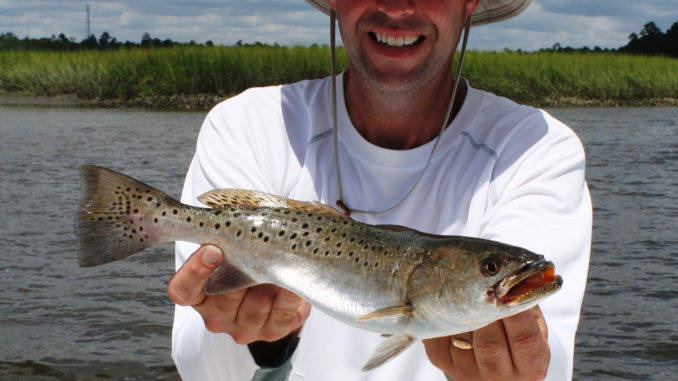
Fish cork rig on high end of tide around submerged oysters for best action
The speckled trout bite is hot in the creeks and inlets around Beaufort, and Lady’s Island resident Blake Stengley said he’s catching more on artificial lures than he does on natural bait.
Stengley has been concentrating most of his efforts out of the Station Creek Landing on Lady’s Island, fishing the creeks that run in and out of Fripp Inlet out of Russ Point Landing. He’s catching most of his specks on Vudu Shrimp and Trout Tricks.
“When I find the trout, it’s a lot easier to take one off the hook and then cast again than it is to get another live shrimp out of the bait well, get it hooked properly, and then cast again. Being able to cast again so quickly keeps me on the fish better,” said Stengly, who concentrates on areas with quick changes in depth that are also near spartina grass and oyster rakes.
Stengley said he’s been catching trout throughout the tide cycle.
“On an incoming tide, I cover those oyster rakes that were exposed at dead low tide,” he said. “I like to fish these lures under a popping cork, and I keep a rod with a short 6-inch leader between cork and lure for fishing the early incoming, and switch to another rod rigged with a 12- to 18-inch leader about an hour into the incoming tide. This keeps the lure from getting hung in the oysters, but still puts it in the target zone.”
On the outgoing tide, Stengley fishes without a cork, letting his lure sink to the bottom, then working it slowly back to the boat, twitching it and letting it fall a few times during the retrieve. He usually catches trout pretty shallow and as near the oyster rakes as the tide allows.
If the bite stops at full tide around these oyster beds, Stengley concentrates on the deep holes and drop-offs near the oysters and grass. Again, he lets the lure sink all the way to the bottom, then works it back slowly with intermittent twitches.
“Sometimes the trout hit it on the way down, so you have to keep the line tight and pay attention,” said Stengley, who at dead low tide starts out fishing these same deep holes, then moves toward the oysters and grass as the tide begins rolling in.





Be the first to comment